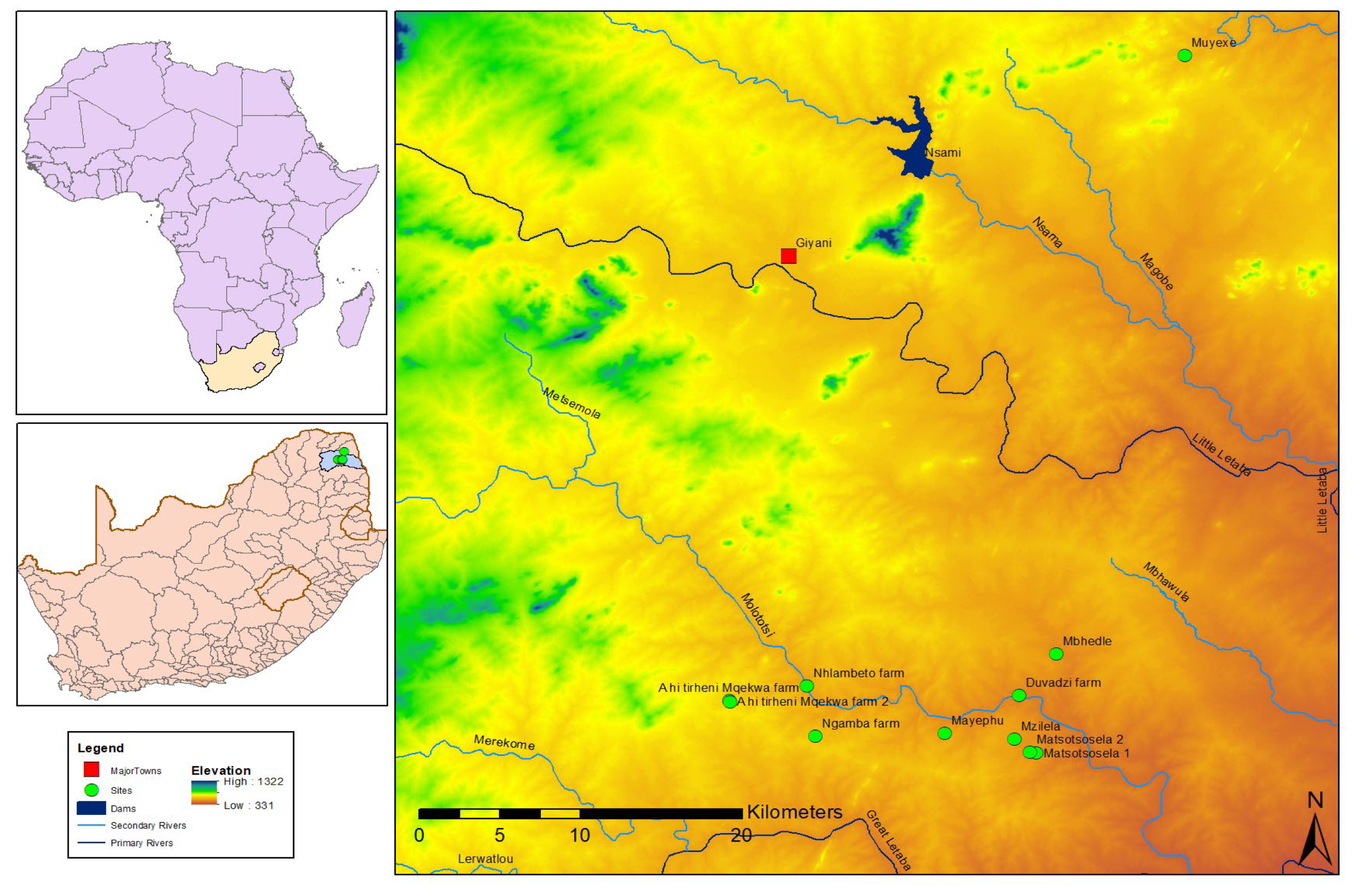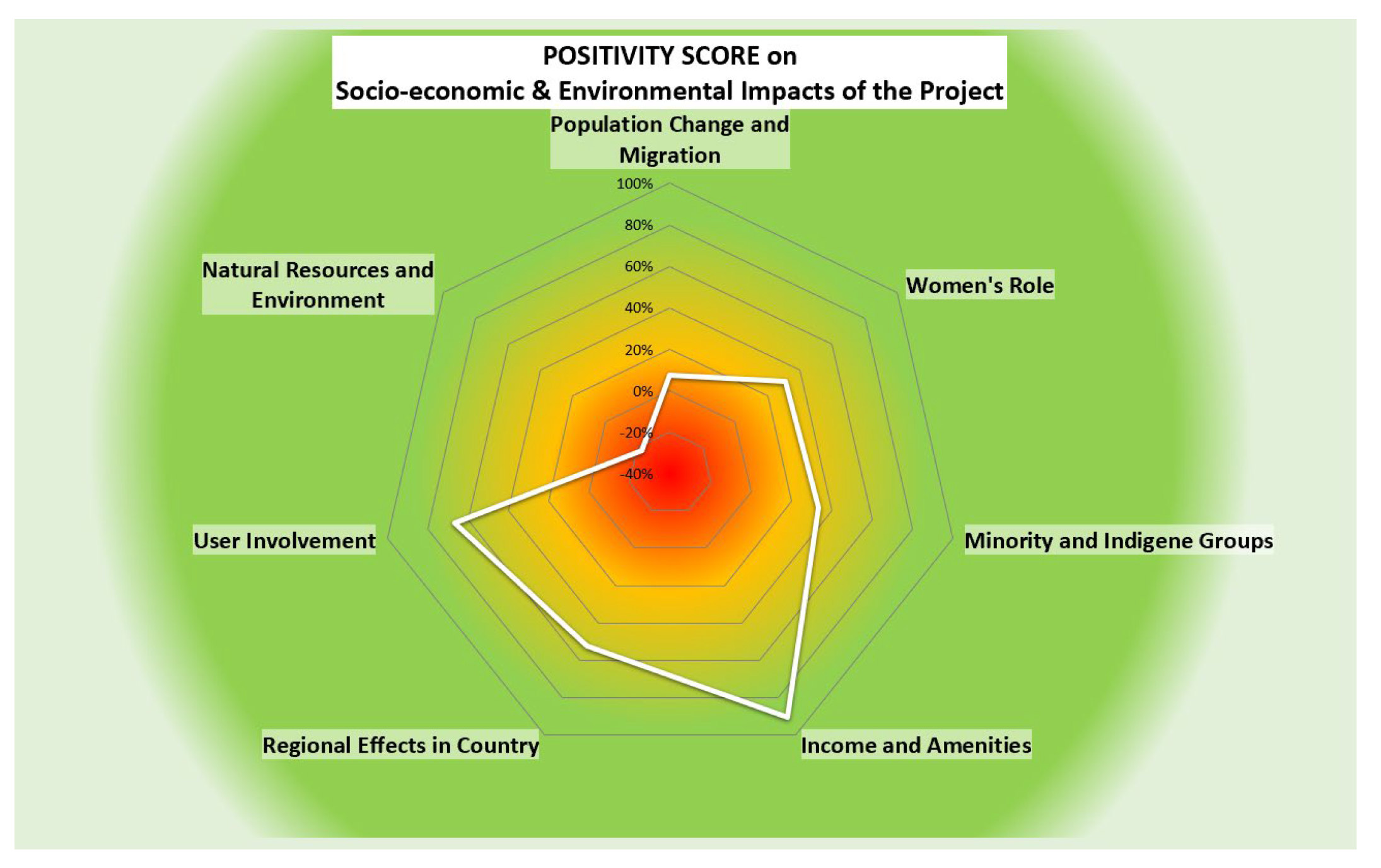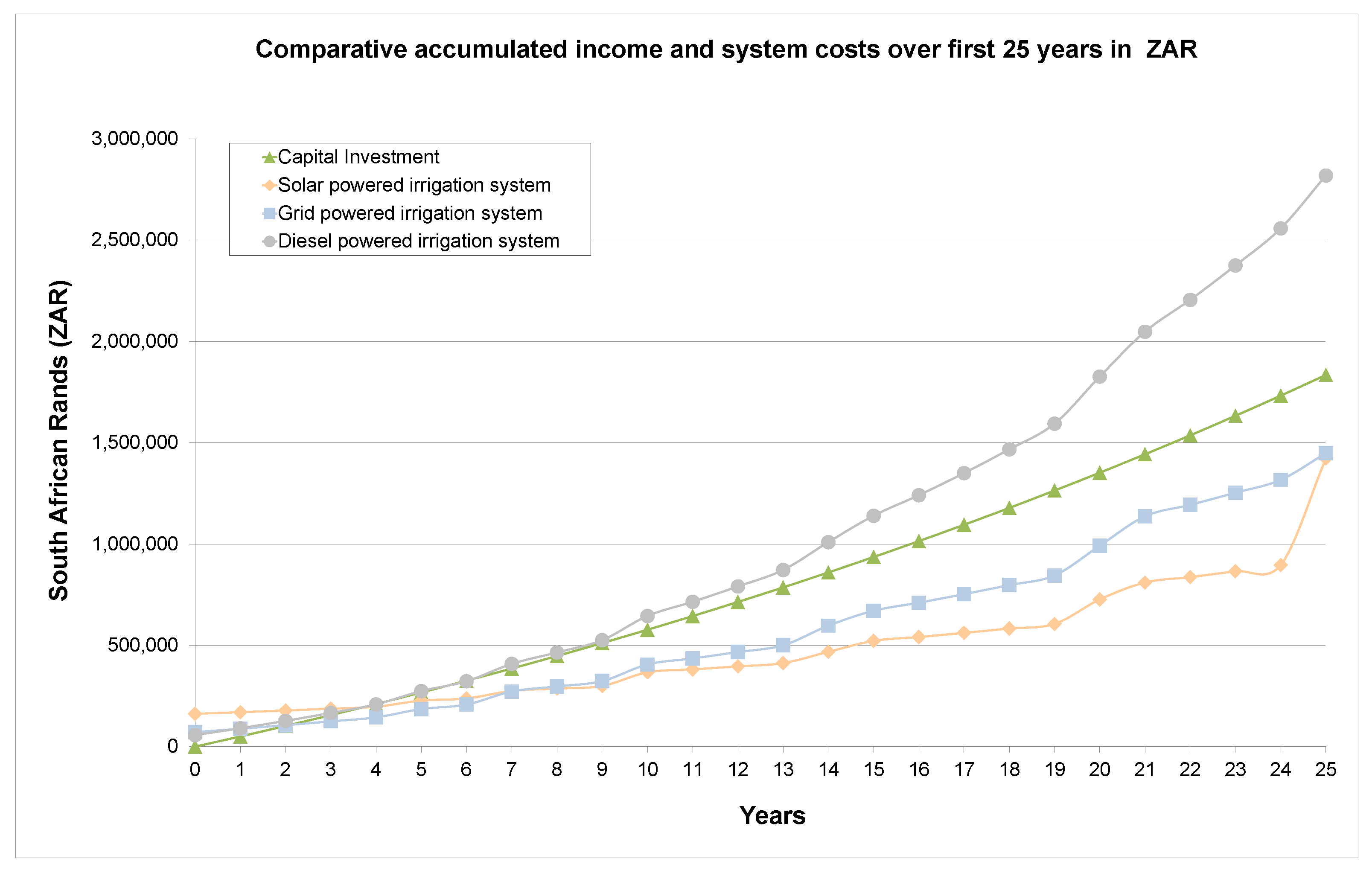Feasibility of Solar-Powered Groundwater Pumping Systems in Rural Areas of Greater Giyani Municipality (Limpopo, South Africa)
Abstract
:1. Introduction
2. Materials and Methods
2.1. Description of Study Area
2.2. Stakeholder Engagement
2.3. Feasibility Study
3. Results
3.1. Outcomes of Stakeholder Engagement
3.2. Feasibility Assessment
4. Discussion
5. Conclusions
Supplementary Materials
Author Contributions
Funding
Institutional Review Board Statement
Informed Consent Statement
Data Availability Statement
Acknowledgments
Conflicts of Interest
References
- Jury, M.R. South Africa’s Future Climate: Trends and Projections. In The Geography of South Africa; Knight, J., Rogerson, C., Eds.; World Regional Geography Book Series; Springer: Cham, Switzerland, 2019. [Google Scholar] [CrossRef]
- WRC. Water Research Commission Corporate Plan 18/23: 2018/19–2022/23; Water Research Commission: Pretoria, South Africa, 2018. [Google Scholar]
- Petja, B.M. Perspectives of Development under Climate Change and the need to invest in a climate resilient future. Dev. Financ. Agenda 2017, 3, 14–16. [Google Scholar]
- Le Maitre, D.C.; Seyler, H.; Holland, M.; Smith-Adao, L.; Nel, J.L.; Maherry, A.; Witthüser, K. Identification, Delineation and Importance of the Strategic Water Source Areas of South Africa, Lesotho and Swaziland for Surface Water and Groundwater; Report No. TT 743/1/18; Water Research Commission: Pretoria, South Africa, 2018. [Google Scholar]
- Owen, R.J.S. The Use of Shallow Alluvial Aquifers for Small Scale Irrigation with Reference to Zimbabwe; Final report of ODA Project R4239; University of Zimbabwe and Southampton University: Harare, Zimbabwe; Southampton, UK, 1989; p. 121. [Google Scholar]
- Love, D.; Van der Zaag, P.; Uhlenbrook, S.; Owen, R.J.S. A water balance modelling approach to optimising the use of water resources in ephemeral sand rivers. River Res. Appl. 2011, 27, 908–925. [Google Scholar] [CrossRef]
- Walker, D.; Jovanovic, N.; Bugan, R.; Abiye, T.; Du Preez, D.; Parkin, G.; Gowing, J. Alluvial aquifer characterisation and resource assessment of the Molototsi sand river, Limpopo, South Africa. J. Hydrol. Reg. Stud. 2018, 19, 177–192. [Google Scholar] [CrossRef]
- Van Koppen, B.; Smits, S.; Moriarty, P.; Penning De Vries, F.; Mikhail, M.; Boelee, E. Climbing the Water Ladder: Multiple-Use Water Services for Poverty Reduction; TP Series No. 52. IRC International Water and Sanitation Centre and International Water Management Institute: Hague, The Netherlands, 2009. [Google Scholar]
- Smits, S.; Van Koppen, B.; Moriarty, P.; Butterworth, J. Multiple-use services as an alternative to rural water supply services: A characterisation of the approach. Water Altern. 2010, 3, 102–121. [Google Scholar]
- Rautanen, S.-L.; Van Koppen, B.; Wagle, N. Community-driven multiple use water services: Lessons learned by the Rural Village Water Resources Management Project in Nepal. Water Altern. 2014, 7, 160–177. [Google Scholar]
- Agrawal, S.; Jain, A. Sustainable deployment of solar irrigation pumps: Key determinants and strategies. WIREs Energy Environ. 2018, 8, e325. [Google Scholar] [CrossRef]
- Aliyu, M.; Hassan, G.; Said, S.A.; Siddiqu, M.U.; Alawami, A.T. A review of solar-powered water pumping systems. Renew. Sustain. Energy Rev. 2018, 87, 61–76. [Google Scholar] [CrossRef]
- Lefore, N.; Closas, A.; Schmitter, P. Solar for all: A framework to deliver inclusive and environmentally sustainable solar irrigation for smallholder agriculture. Energy Policy 2021, 154, 112313. [Google Scholar] [CrossRef]
- Hartung, H.; Pluschke, L. The Benefits and Risks of Solar-Powered Irrigation—A Global Overview; The Food and Agriculture Organization of the United Nations and Deutsche Gesellschaft für Internationale Zusammenarbeit: Rome, Italy; Bonn, Germany, 2018; Available online: http://www.fao.org/3/i9047en/I9047EN.pdf (accessed on 2 June 2021).
- GIZ. Solar Powered Irrigation Systems (SPIS): Technology, Economy, Impacts; Deutsche Gesellschaft für Internationale Zusammenarbeit: Bonn, Germany, 2020; Available online: https://energypedia.info/images/7/74/Solar_Powered_Irrigation_Systems_%28SPIS%29_-_Technology%2C_Economy%2C_Impacts.pdf (accessed on 2 June 2021).
- Kelley, L.C.; Gilbertson, E.; Sheikh, A.; Eppinger, S.D.; Dubowsky, S. On the feasibility of solar-powered irrigation. Renew. Sustain. Energy Rev. 2010, 14, 2669–2682. [Google Scholar] [CrossRef]
- Sarr, A. Technical and Economic Feasibility of Solar Pump Irrigation in the North-Niayes Region in Senegal. In MSc in Land and Water Resources Management: Irrigated Agriculture; CIHEAM: Bari, Italy, 2020. [Google Scholar]
- Rubio-Allaga, A.; Sanchez-Lozano, J.M.; Garcia-Cascales, M.S.; Benhamou, M.; Molina-Garcia, A. GIS based solar resource analysis for irrigation purposes: Rural areas comparison under groundwater scarcity conditions. Sol. Energy Mater. Sol. Cells 2016, 156, 128–139. [Google Scholar] [CrossRef]
- Merino, L.M.; Fernandez, N.I.; Valsero, J.J.D.; Aguilera, H. Concentrating solar power plants versus groundwater resources in Mediterranean areas of Spain: The environmental dilemma. J. Environ. Manag. 2018, 206, 409–417. [Google Scholar] [CrossRef]
- Schmitter, P.; Kibret, K.S.; Lefore, N.; Barron, J. Suitability mapping framework for solar photovoltaic pumps for smallholder farmers in sub-Saharan Africa. Appl. Geogr. 2018, 94, 41–57. [Google Scholar] [CrossRef]
- Sayed, E.; Riad, P.; Elbeih, A.; Hagras, M.; Hassan, A.A. Multi criteria analysis for groundwater management using solar energy in Moghra Oasis, Egypt. Egypt. J. Remote Sens. Space Sci. 2019, 22, 227–235. [Google Scholar] [CrossRef]
- Brahmi, A.; Abounada, A.; Chbirik, G.; El Amrani, A. Design and Optimal Choice of a 1.5 kW Photovoltaic Pumping System for Irrigation Purposes. AIP Conf. Proc. 2018, 2056, 020004. [Google Scholar] [CrossRef]
- Hadidi, A.; Yaichi, M. Solar system design for water pumping. E3S Web Conf. 2018, 37, 06001. [Google Scholar] [CrossRef]
- Elbaset, A.A.; Ata, S.I.H. Optimum photovoltaic solar cells area estimation for feeding micro-grid loads. Int. J. Eng. Res. Technol. 2019, 12, 1978–1985. [Google Scholar]
- Santra, P. Performance evaluation of solar PV pumping system for providing irrigation through micro-irrigation techniques using surface water resources in hot arid region of India. Agric. Water Manag. 2021, 245, 106554. [Google Scholar] [CrossRef]
- Singh, D.B.; Mahajan, A.; Devli, D.; Bharti, K.; Kandari, S.; Mittal, G. A mini review on solar energy based pumping system for irrigation. Mater. Today Proc. 2021, 43, 417–425. [Google Scholar] [CrossRef]
- Modi, V. Solar for small-holder farmers made affordable through innovative co-design and financing—Lessons learnt. Sol. Compass 2022, 3, 100027. [Google Scholar] [CrossRef]
- Girma, M.; Assefa, A.; Molinas, M. Feasibility study of a solar photovoltaic water pumping system for rural Ethiopia. Environ. Sci. 2015, 2, 697–717. [Google Scholar] [CrossRef]
- Yorkor, B.; Leton, T.G. Solar water supply for rural communities in Reiver States, Niger Delta of Nigeria. Int. J. Energy Environ. Res. 2017, 5, 1–17. [Google Scholar]
- Salilih, E.M.; Birhane, Y.T.; Arshi, S.H. Performance analysis of DC type variable speed solar pumping system under various pumping heads. Sol. Energy 2020, 208, 1039–1047. [Google Scholar] [CrossRef]
- Tiwari, A.K.; Kalamkar, V.R.; Pande, R.R.; Sharma, S.K.; Sontale, C.M.; Jha, A. Effect of head and PV array configurations on solar water pumping system. Mater. Today Proc. 2020, 46, 5475–5481. [Google Scholar] [CrossRef]
- Mohammed, C.; Hassan, Z.; Larbi, M.E.; Smail, Z.; Jalal, B. Optimal sizing of a concentrated solar power system powering an autonomous water pumping system using the modified electric systems cascade analysis. Mater. Today Proc. 2021, 45, 7747–7751. [Google Scholar] [CrossRef]
- Hadwan, M.; Alkholidi, A. Assessment of factors influencing the sustainable performance of photovoltaic water pumping systems. Renew. Sustain. Energy Rev. 2018, 92, 307–318. [Google Scholar] [CrossRef]
- Ali, A.; Rahut, D.B.; Behera, B. Factors influencing farmers’ adoption of energy-based water pumps and impacts on crop productivity and household income in Pakistan. Renew. Sustain. Energy Rev. 2016, 54, 48–57. [Google Scholar] [CrossRef]
- Closas, A.; Rap, E. Solar-based groundwater pumping for irrigation: Sustainability, policies, and limitations. Energy Policy 2017, 104, 33–37. [Google Scholar] [CrossRef]
- Rathore, P.K.S.; Das, S.S.; Chauhan, D.S. Perspectives of solar photovoltaic water pumping for irrigation in India. Energy Strategy Rev. 2018, 22, 385–395. [Google Scholar] [CrossRef]
- Shah, T.; Rajan, A.; Rai, G.P.; Verma, S.; Durga, N. Solar pumps and South Asia’s energy-groundwater nexus: Exploring implications and reimagining its future. Environ. Res. Lett. 2018, 13, 115003. [Google Scholar] [CrossRef]
- Masiyandima, M.C.; Sow, A. Agricultural water and energy use in the Senegal River Valley. In AGU Fall Meeting Abstracts; American Geophysical Union: Washington, DC, USA, 2015; p. H13G-1624. [Google Scholar]
- Kamel, S.; Dahl, C. The economics of hybrid power systems for sustainable desert agriculture in Egypt. Energy 2005, 30, 1271–1281. [Google Scholar] [CrossRef]
- Powell, J.W.; Welsh, J.M.; Farquharson, R. Investment analysis of solar energy in a hybrid diesel irrigation pumping system in New South Wales, Australia. J. Clean. Prod. 2019, 224, 444–454. [Google Scholar] [CrossRef]
- Jadhav, P.J.; Sawant, N.; Panicker, A.M. Technical paradigms in electricity supply for irrigation pumps: Case of Maharashtra, India. Energy Sustain. Dev. 2020, 58, 50–62. [Google Scholar] [CrossRef]
- Hoffman, A.R. The Connection: Water and Energy Security. Energy Security; Institute for the Analysis of Global Security: Washington, DC, USA, 2004; Available online: http://www.iags.org/n0813043.htm (accessed on 30 May 2021).
- Bastakoti, R.; Raut, M.; Thapa, B.R. Groundwater Governance and Adoption of Solar-Powered Irrigation Pumps: Experiences from the Eastern Gangetic Plains; Water Knowledge Note; World Bank: Washington, DC, USA, 2019; Available online: http://hdl.handle.net/10986/33245 (accessed on 2 June 2021).
- Gupta, E. The impact of solar water pumps on energy-water-food nexus: Evidence from Rajasthan, India. Energy Policy 2019, 129, 598–609. [Google Scholar] [CrossRef]
- Ghasemi-Mobtaker, H.; Mostashari-Rad, F.; Saber, Z.; Cahu, K.-W.; Nabavi-Pelesaraei, A. Application of photovoltaic system to modify energy use, environmental damages and cumulative exergy demand of two irrigation systems-A case study: Barley production of Iran. Renew. Energy 2020, 160, 1316–1334. [Google Scholar] [CrossRef]
- Armanuos, A.M.; Negm, A.; El Tahan, A.H.M.H. Life cycle assessment of diesel fuel and solar pumps in operation stage for rice cultivation in Tanta, Nile Delta, Egypt. Procedia Technol. 2016, 22, 478–485. [Google Scholar] [CrossRef] [Green Version]
- Rubio-Allaga, A.; Garcia-Cascales, M.S.; Sanchez-Lozano, J.M.; Molina-Garcia, A. Multidimensional analysis of groundwater pumping for irrigation purposes: Economic, energy and environmental characterization for PV power plant integration. Renew. Energy 2019, 138, 174–186. [Google Scholar] [CrossRef]
- Rubio-Allaga, A.; Garcia-Cascales, M.S.; Sanchez-Lozano, J.M.; Molina-Garcia, A. MCDM-based multidimensional approach for selection of optimal groundwater pumping systems: Design and case example. Renew. Energy 2021, 163, 213–224. [Google Scholar] [CrossRef]
- Shinde, V.B.; Wandre, S.S. Solar photovoltaic water pumping system for irrigation: A review. Afr. J. Agric. Res. 2015, 10, 2267–2273. [Google Scholar] [CrossRef] [Green Version]
- GIZ; FAO. Toolbox on Solar Powered Irrigation Systems (SPIS). 2021. Available online: https://energypedia.info/wiki/Toolbox_on_SPIS (accessed on 8 June 2021).
- Greater Giyani Municipality IDP. Greater Giyani Municipality, Integrated Development Plan 2021–2022 Draft. 2021. Available online: http://www.greatergiyani.gov.za/documents/idp.php (accessed on 1 June 2021).
- DWA. Classification of Water Resources and Determination of the Resource Quality Objectives in the Letaba Catchment. In Resource Quality Objectives; Rivers for Africa eFlows Consulting (Pty) Ltd. DWA Report RDM/WMA02/00/CON/CLA/0314, May 2014; Department of Water Affairs: Pretoria, South Africa, 2014. [Google Scholar]
- Holland, M. Hydrological Characterization of Crystalline Basement Aquifers within the Limpopo Province, South Africa. Ph.D. Thesis, University of Pretoria, Pretoria, South Africa, 2011. [Google Scholar]
- Mopani District Municipality. Mopani District Municipality Integrated Development Plan 2016–2017; Department of Cooperative Governance and Traditional Affairs: Pretoria, South Africa, 2016. [Google Scholar]
- Greater Giyani Municipality. Integrated Development Plan (2010–2013), Greater Giyani Municipality. 2010. Available online: http://www.lda.gov.za/index.php?option=com_content&view=article&id=60&Itemid=55 (accessed on 15 March 2012).
- Greater Giyani Municipality (2013/2014) Final Draft: Greater Giyani Municipality Integrated Development Plan. 2013–2014. Available online: http://www.greatergiyani.gov.za/docs/reports/Final%20draft%20GGM%20IDP%202013%2014.pdf (accessed on 2 June 2021).
- FAO. Irrigation Water Management: Training Manual No. 3. 1986. Available online: http://www.fao.org/3/s2022e/s2022e00.htm#Contents (accessed on 30 August 2021).
- Allen, R.G.; Pereira, L.S.; Raes, D.; Smith, M. Crop Evapotranspiration. FAO Irrigation and Drainage Paper 56; Food and Agriculture Organization (FAO): Rome, Italy, 1998. [Google Scholar]
- Pereira, L.S.; Paredes, P.; Hunsaker, D.J.; Lopez-Urrea, R.; Jovanovic, N. Special Issue Editorial: Updates and advances to the FAO56 crop water requirements method. Agric. Water Manag. 2021, 248, 106697. [Google Scholar] [CrossRef]
- Government of Western Australia. Calculating Livestock Water Requirements for Small Landholders. 2017. Available online: https://www.agric.wa.gov.au/small-landholders-western-australia/calculating-livestock-water-requirements-small-landholders?page=0%2C1 (accessed on 30 August 2021).
- DWAF. South African Water Quality Guidelines, 2nd ed.; Department of Water Affairs and Forestry: Pretoria, South Africa, 1996. [Google Scholar]
- Jovanovic, N.; Bugan, R.D.H.; Lebea, T.J.; Ayisi, K.K.; Kena, M.; Mushadu, W.; Du Preez, D.; Walker, D.; Whitehead, R. Riparian Shallow Groundwater Utilization for Small-Holder Irrigation in the Mopani District (Limpopo Province); Report No. 2426/1/18; Water Research Commission: Pretoria, South Africa, 2018. [Google Scholar]
- Meir, Y.B.; Opfer, K.; Hernandez, E. Decentralized renewable energies and the water-energy-food nexus in rural Morocco. Environ. Chall. 2022, 6, 100432. [Google Scholar] [CrossRef]
- Prasad, P.; Duker, A.; de Fraiture, C.; van der Zaag, P. Irrigation development under uncertainty: A call for adaptive investment pathways. Environ. Sci. Policy 2023, 140, 104–110. [Google Scholar] [CrossRef]
- Mmbadi, E. Water Security in Rural Limpopo in a Changing Climate: A Study of the Greater-Giyani Local Municipality, South Africa. Master’s Thesis, Department of Geography and Geo-Information Sciences, University of Venda, Thohoyandou, South Africa, 2019. [Google Scholar]



| Village | Site | Water Use | Borehole Depth (m) | Water Requirements (m3/d) | Total Dynamic Head (m) | Pipeline Length (m) | Pipeline Diameter (mm) | Peak Power (kWp) | Solar Panel Surface (m2) |
|---|---|---|---|---|---|---|---|---|---|
| Mbhedle | Population = 1230 | Domestic, livestock | 80–90 | 30.8 1 | 33 | 1000 | 60 | 1.5–1.7 | 10.0–11.3 |
| Mayephu | Population = 1940 | Domestic, livestock | 80–90 | 48.5 1 | 30 | 50 | 60 | 2.2–2.7 | 14.3–18.0 |
| Mzilela | Population = 1150 | Domestic, livestock | 80–90 | 28.8 1 | 29 | 50 | 60 | 1.2–1.3 | 8.0–8.7 |
| Matsotsosela | Population = 2300 | Domestic, livestock | 80–90 | 57.5 1 | 30 | 50 | 60 | 2.8–3.4 | 18.7–22.3 |
| Dzumeri | Nhlambeto Primary Agricultural Cooperative | Domestic, agriculture | 4 | 58.9 2 | 20 | 300 | 60 | 1.7–2.0 | 11.0–13.0 |
| Dzumeri | Matsambo Ngamba Projects | Agriculture | 66 | 33.9 | 35 | 150 | 40 | 1.7–2.0 | 11.3–13.3 |
| Dzumeri (Daniel Ravalela) | A hi tirheni Mqekwa Primary Agricultural Cooperative | Agriculture | 120 | 33.9 | 43 | 300 | 40 | 2.1–2.6 | 14.0–17.3 |
| Loloka | Duvadzi Youth Organic Agricultural Cooperative | Agriculture | 120 | 33.9 | 35 | 150 | 40 | 1.7–2.0 | 11.3–13.3 |
| Muyexe | Macena Primary Agricultural Cooperative | Agriculture | 40 | 33.9 | 40 | 250 | 40 | 2.0–2.5 | 13.0–16.7 |
| Crop Water Requirement (m3 d−1) | |||||||||||||
|---|---|---|---|---|---|---|---|---|---|---|---|---|---|
| Crops | Area (ha) | Jan | Feb | Mar | Apr | May | Jun | Jul | Aug | Sep | Oct | Nov | Dec |
| Tomato | 0.5 | 10.1 | 22.1 | 29.9 | 12.1 | - | - | - | - | - | - | - | 7.2 |
| Tomato | 0.5 | - | - | - | - | 10.4 | 15.3 | 19.8 | 27.8 | 24.8 | 6.9 | - | - |
| Tomato | 0.5 | 19.8 | 4.8 | - | - | - | - | - | - | - | 13.4 | 20.6 | 26.2 |
| Total | 1.5 | 29.9 | 26.9 | 29.9 | 12.1 | 10.4 | 15.3 | 19.8 | 27.8 | 24.8 | 20.3 | 20.6 | 33.4 |
| Livestock water requirements (m3 d−1) | |||||||||||||
| Livestock | No. of heads | ||||||||||||
| Cattle (adult, dry) | 5 | 0.5 | 0.5 | 0.5 | 0.25 | 0.25 | 0.25 | 0.25 | 0.25 | 0.25 | 0.5 | 0.5 | 0.5 |
| Total water requirements (m3 d−1) | |||||||||||||
| Total | 30.4 | 27.4 | 30.4 | 12.3 | 10.7 | 15.5 | 20.0 | 28.0 | 25.0 | 20.8 | 21.1 | 33.9 | |
| Financial Indicator | Solar-Powered | Grid Electricity | Diesel |
|---|---|---|---|
| Internal rate of return over 25 years | 25% | 43% | Not feasible |
| Net present value over 25 years (ZAR) | 4,063,542 | 2,962,363 | −2,870,302 |
| Accumulated cash flow after 25 years (ZAR) | 412,398 | 385,915 | −984,141 |
| System life cycle cost (25 years) (ZAR) | 1,422,232 | 1,448715 | 2,818,771 |
| Years to payback | 4 | 3 | No payback |
| CO2 emissions per year (kg·a−1) | 0 | 956 | 3869 |
Disclaimer/Publisher’s Note: The statements, opinions and data contained in all publications are solely those of the individual author(s) and contributor(s) and not of MDPI and/or the editor(s). MDPI and/or the editor(s) disclaim responsibility for any injury to people or property resulting from any ideas, methods, instructions or products referred to in the content. |
© 2023 by the authors. Licensee MDPI, Basel, Switzerland. This article is an open access article distributed under the terms and conditions of the Creative Commons Attribution (CC BY) license (https://creativecommons.org/licenses/by/4.0/).
Share and Cite
Jovanović, N.; Mpambo, M.; Willoughby, A.; Maswanganye, E.; Mazvimavi, D.; Petja, B.; Molose, V.; Sifundza, Z.; Phasha, K.; Ngoveni, B.; et al. Feasibility of Solar-Powered Groundwater Pumping Systems in Rural Areas of Greater Giyani Municipality (Limpopo, South Africa). Appl. Sci. 2023, 13, 3859. https://doi.org/10.3390/app13063859
Jovanović N, Mpambo M, Willoughby A, Maswanganye E, Mazvimavi D, Petja B, Molose V, Sifundza Z, Phasha K, Ngoveni B, et al. Feasibility of Solar-Powered Groundwater Pumping Systems in Rural Areas of Greater Giyani Municipality (Limpopo, South Africa). Applied Sciences. 2023; 13(6):3859. https://doi.org/10.3390/app13063859
Chicago/Turabian StyleJovanović, Nebojša, Mandelwa Mpambo, Alana Willoughby, Eugene Maswanganye, Dominic Mazvimavi, Brilliant Petja, Virginia Molose, Zanele Sifundza, Kenny Phasha, Basani Ngoveni, and et al. 2023. "Feasibility of Solar-Powered Groundwater Pumping Systems in Rural Areas of Greater Giyani Municipality (Limpopo, South Africa)" Applied Sciences 13, no. 6: 3859. https://doi.org/10.3390/app13063859






